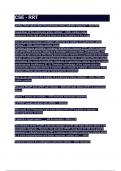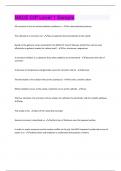CSE - RRT
cardiac What values does the pulmonary artery catheter measure? - ANS-PAP
Capabilities of the pulmonary artery catheter: - ANS--cardiac output
-pressures in the right side of the heart and in the arteries of the lungs
How will positive pressure ventilation affect the the reading of a pulmonary artery
catheter? - ANS--decrease cardiac output
-Positive pressure ventilation increases intrathoracic pressure (ITP), which increases
right atrial (RA) pressure, leading to a decrease in venous return. Subsequently, this
decreased right ventricle (RV) filling decreases left ventricle (LV) preload and allows for
greater LV contraction with decreased energy expenditure. In patients who are volume
overloaded, this could be beneficial. However, in hypovolemic patients, this may induce
cardiovascular insufficiency [2, 3]. Therefore, knowledge of the volume status of
mechanically ventilated patients is essential. On critically ill patients, pulmonary artery
catheters (PACs) can be used for hemodynamic monitoring
How do you determine the integrity of a pulmonary artery catheter? - ANS--CXR will
confirm position
Elevated PCWP and mPAP can indicate: - ANS-left heart failure (CHF) w/ pulmonary
edema
Spiked T waves can indicate: - ANS-possible electrolyte imbalance
Is PCWP usually elevated with ARDS? - ANS-No
With acute Cor Pulmonale (right heart failure) will CVP increase or decrese? -
ANS-significantly increase
If patient is hypervolemic ___ will be elevated - ANS-CVP
The elevation of the PCWP is the key indicator of CHF (left heart failure), which is an
acceptable diagnosis. However, the elevated mPAP, along with the BS and general
appearance, indicated that the CHF is causing a cardiogenic pulmonary edema which
is. a more comprehensive and better response. cardiac sim 1 - ANS-
Treatment options for cardiogenic pulmonary edema: - ANS--Morphine
,-Furosemide (Lasix)
-Increase O2 if hypoxic
How can SvO2 be measured? - ANS--Pulmonary artery catheter w/ a built in reflective
pulse oximeter.
-Current technology does not allow us to insert a separate line within the normal
4-lumen catheter or to insert a line in addition to the pulmonary artery line
-if normal 4 lumen catheter is in place it will be necessary to replace the current catheter
w/ one that has this specific capability
What is SVRI? - ANS--systemic vascular resistance index
-The physiological meaning of SVRI is the tension or pressure that builds up in the wall
of the left ventricle during ejection.
Equation for SVRI: - ANS-(MAP-CVP)/CI
SVRI normal - ANS-1970-2390 dynes .sec/cm5/m2
MAP normal - ANS--mean arterial pressure)
-93-94 mmhg
MAP equation - ANS-determined by taking the systolic pressure, adding the diastolic
pressure twice, and dividing by the number 3 (heart spends twice as much time in
diastole than in systole)
CI normal - ANS--cardiac index
-2.5-4.0L/min/m2
CI equation - ANS-cardiac output/body surface area (BSA)
Normal PCWP means ___ is working well - ANS-left heart
Elevated mPAP and CVP indicate the problem is in the ____________ - ANS-lungs and
backing up into the right heart
Normal cardiac index = - ANS-good left heart function
Normal PCWP = - ANS-good left heart function
Mildly elevated PVR = - ANS-lung trouble
,Sudden fall in PECO2 with a wide disparity b/w that value and the PaCO2 is a very
strong indicator of an increased alveolar deadspace caused by a pulmonary embolism
and the hemodynamic values are consistent with an circulatory obstruction in the lungs
sim 2 - ANS-
A _______ ______ will suddenly block perfusion to an area of the lungs and cause
alveolar deadspace ventilation. This causes the exhaled CO2 to drop while the arterial
CO2 remains stable - ANS-pulmonary embolism
Administration of t-PA is for - ANS--potential tx for PE but very expensive and premature
to administer for initial tx
Administration of warfarin (Coumadin) is for - ANS--potential PE tx, takes time to build
up in the blood stream and could be recommended when pt is ready to go home
Administration of streptokinase is for - ANS--potential tx for PE but very expensive and
premature to administer for initial tx
Administration of IV heparin is for - ANS--standard initial treatment for pulmonary emboli
-quickly reduces the possibility of further clots from forming and causing additional
emboli
What is cardiac index? (CI) - ANS-A cardiodynamic measure based on the cardiac
output, which is the amount of blood the left ventricle ejects into the systemic circulation
in one minute, measured in liters per minute (l/min). Cardiac output is indexed to a
patient's body size by dividing by the body surface area to yield the cardiac index.
CXR showing reduced perfusion = - ANS-PE
What is slow vital capacity? - ANS-Exhalation is performed slowly
What is a maximum inspiratory pressure? (MIP) - ANS-forceful exhalation, then breathe
in as deep as you can\
Normal MIP/NIF - ANS--20 cmH20 or greater is acceptable range
What would a platelet count be useful for? - ANS--A platelet count is a test that
measures the number of platelets in your blood. Platelets are cells that help your blood
, clot. Too few platelets can be a sign of cancer, infections or other health problems. Too
many platelets put you at risk for blood clots or stroke.
-Platelets, or thrombocytes, are tiny blood cells that bud from cells in the bone marrow
(megakaryocytes). Platelets form clots when there's damage to a blood vessel. For
example, if you cut your finger, platelets mix with clotting factors (proteins in the blood).
Together, they form a "glue" that stops the bleeding. There are tens of thousands of
platelets in a single drop of blood.
-A platelet count is usually part of a complete blood count. This test measures the
number of platelets, white blood cells and red blood cells. The bone marrow makes
blood cells.
-Or they may do the test if they think you have:
Thrombocytopenia (low platelet count).
Thrombocytosis (high platelet count).
thrombocytopenia is associated with - ANS--excessive bleeding, not enough platelets to
clot blood properly
-Alcohol use disorder and alcoholism.
******Autoimmune disease which causes ITP. ITP is sometimes associated with other
autoimmune conditions such as lupus.
-Bone marrow diseases, including aplastic anemia, leukemia, certain lymphomas and
myelodysplastic syndromes.
-Cancer treatments like chemotherapy and radiation therapy.
-Enlarged spleen caused by cirrhosis of the liver or Gaucher disease. The enlarged
spleen traps platelets and other blood cells and prevents them from circulating in the
blood stream.
******Exposure to toxic chemicals, including arsenic, benzene and pesticides.
******Medications to treat bacterial infections (antibiotics), seizures (epilepsy) and heart
problems, or the blood thinner heparin.
******Viruses, such as hepatitis C, CMV, EBV and HIV.
thrombocytosis is associated with - ANS--condition in which there are an excessive
number of platelets in the blood. Platelets are blood cells in plasma that stop bleeding
by sticking together to form a clot. Too many platelets can lead to certain conditions,
such as stroke, heart attack or a clot in the blood vessels.
-Anemia due to iron deficiency
-Cancer
-Inflammation or infection
-Surgery, especially splenectomy (removal of the spleen).





